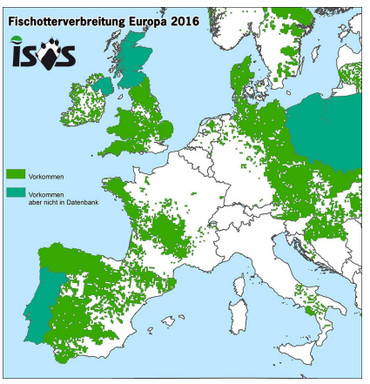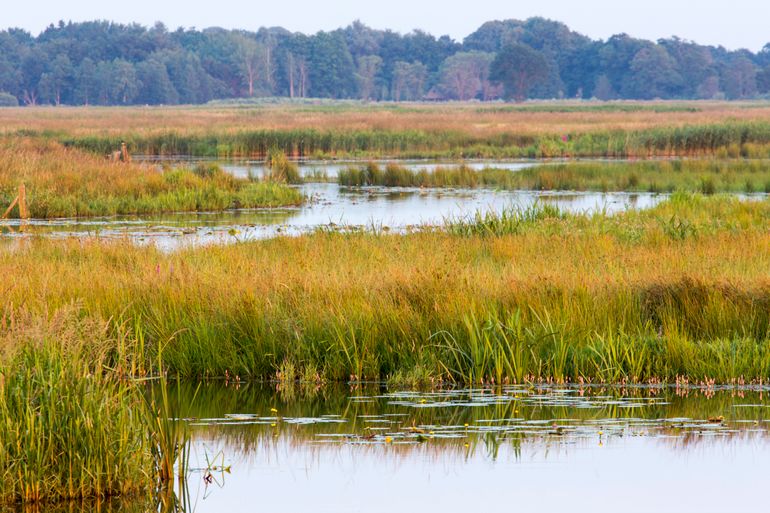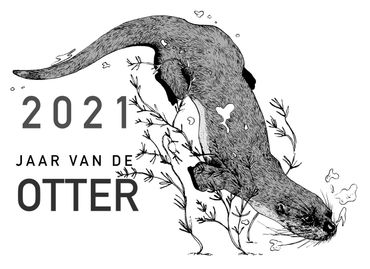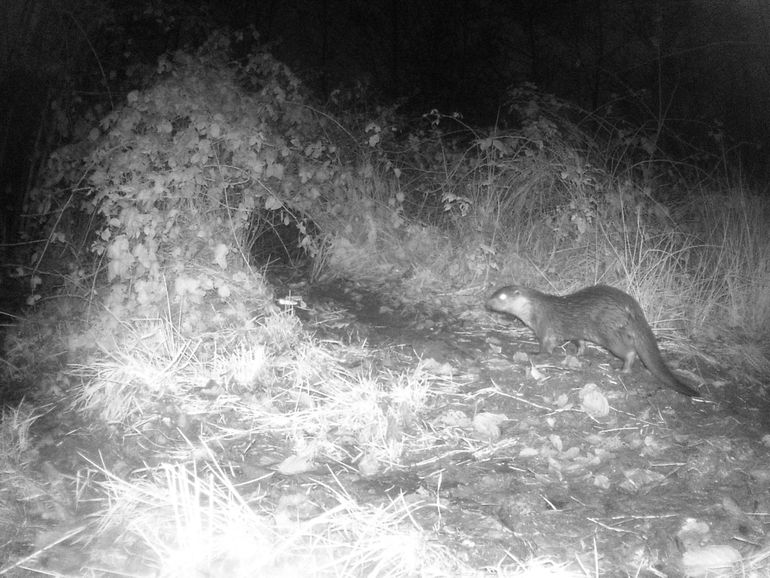
Borders form no obstacle for otters in Germany, Belgium and The Netherlands
Dutch Mammal Society, Otterzentrum Hankensbuttel, Senckenberg Center for Wildlife Genetics, Wageningen Environmental ResearchTransboundary otter webinar
This was one of the conclusions of a transboundary webinar that was organized by CaLutra, the otter- and beaver working group of the Dutch Mammal Society on the 25th of November. The webinar was organized to inspire people on both sides of the border. Six interesting lectures, as well as examples of implemented measures, were shared by speakers from Germany, Belgium and The Netherlands. The complete webinar can still be watched on Youtube.com/calutra.
Ottergap in Europe
 In central Europe, a distribution map of otters from 2016 shows a ‘gap’ in the population. Yet, since the otter is protected, and measures are taken to improve river banks and water, the otter is recovering and the populations in eastern Europe and southwestern Europe are slowly growing towards each other. In between these populations, the reintroduced population in The Netherlands has been developing since 2002. Lately, the Dutch otter population has even crossed the borders of Belgium and Germany, where it moved into the states of Lower Saxony and North Rhine-Westphalia. Therefore, next year the distribution map will be updated.
In central Europe, a distribution map of otters from 2016 shows a ‘gap’ in the population. Yet, since the otter is protected, and measures are taken to improve river banks and water, the otter is recovering and the populations in eastern Europe and southwestern Europe are slowly growing towards each other. In between these populations, the reintroduced population in The Netherlands has been developing since 2002. Lately, the Dutch otter population has even crossed the borders of Belgium and Germany, where it moved into the states of Lower Saxony and North Rhine-Westphalia. Therefore, next year the distribution map will be updated.
Exchange in Lower Saxony
Friederike Schröder of the NGO Otterzentrum Hankensbüttel wanted to investigate if the populations in the Netherlands and eastern Europe were already mixed. Therefore she started studying the otter in southwest Lower Saxony in 2019. The project 'Actionplan Fischotter southwest Lower Saxony' in Grafschaft Bentheim, Emsland and Osnabrück included a genetic analysis and looked into the origin of the individuals in the project area. Berardino Cocchiararo of the German Senckenberg Center for Wildlife genetics analyzed the samples and succeeded to confirm ten individual otters. To be able to check for population exchange, Senckenberg and Arjen de Groot of Wageningen Environmental Research exchanged reference data and streamlined analysis methods for the Dutch and German populations. As a result, seven of the ten otters could be assigned to the Dutch population, while three individuals had migrated from eastern Lower Saxony. This confirms that the otter populations of eastern Europe and The Netherlands have mixed for the first time in decennia. Unfortunately, no mixed reproduction could be confirmed.
This project is funded by the European Union program 'Conservation and development of habitats and species' (= Erhalt und Entwicklung von Lebensräumen und Arten (EELA), the 'District of Grafschaft Bentheim', 'Naturschutzstiftung Emsland' and the 'Dr. Joachim und Hanna Schmidt Stiftung für Umwelt und Verkehr'.
Example River Ise (Lower Saxony)
In western Germany, most of the waterbodies are situated north-south, therefore those cannot form an ecological route from east to west. Another barrier for crossborder exchange is that waterbodies have been turned into channels. An example to improve the habitat of otters is the Ise river in eastern Lower Saxony. This is a stream that flows from north to south into the Aller river. It improved from a shallow uniform river with slow flow velocity, to an otter paradise with a riparian strip of minimum ten meters wide, inserting gravel and dead wood to create fish and insect habitats. The riparian bushes provide shelter for otters to rest in. This project can be inspiring for the west of Lower Saxony.

Example Onlanden, The Netherlands
The shortest route from the core area of Wieden-Weerribben for otters in The Netherlands to Germany is via the Onlanden in Groningen. In the north and east of The Netherlands, many measures have been taken to complete The Netherlands Nature Network.
The area Onlanden was transformed from agricultural land to water storage and opened in 2012. This was done because the city of Groningen flooded in 1998 after heavy rainfall, with water from the streams upstream from the hills. After July 2021 everybody in Benelux and Germany is most alert again on the risk of flooding. When the Onlanden area was established as water storage area, already a year after otters discovered it. And one year later, young otters were born. Water storage and otter habitat can be a very good combination. There are more of these water storage areas, throughout The Netherlands.

Example Rhine
Another important route for otters is via river IJssel and Gelderse Poort to North Rhine-Westphalia and Lower Saxony. Here, organisations like the Nature protection centre Kleve and Ark Nature development have worked together in the Greenblue Rhine Alliance to fix bottlenecks for the otter. When the river area in Germany and The Netherlands is improved, a large area of new habitats can be occupied by otters. This consists of solving traffic bottlenecks, water quality improvements, creation of new riparian habitats and creation of coverage on banks.
Two challenges: improve habitat Germany/Netherlands and extend habitat towards France
The current challenge is to improve and connect the otter habitat in Lower Saxony, North Rhine-Westphalia and The Netherlands. The next challenge is to fill the gap towards France. This still is a big distance to overcome, but on the day of the transboundary otter webinar a new sighting of otters was reported in a new area: South-Limburg, close to the borders with Germany and Belgium. This area is a stepping stone towards the habitat in the Ardennes (Wallonia). At the time of the webinar, there was no proof in Wallonia and northern France of a relict population of otters. But very recently at least one otter was sighted in Wallonia. Also, some otters have settled in the Scheldt in Flanders. A likely next step is that the otter will occupy Flanders, Wallonia, Southern Germany and Northern France. In September there will be a congress in Northern France.
Year of the otter was a success
 The Year of the Otter was organized in The Netherlands, Belgium and Germany. Many different organisations have taken actions for the otter and have given publicity about the otter. The Year of the Otter has therefore reached many people. And it is absolutely sure that the people in the low countries love otters: 1.2 million people watched the otter movie ‘The Otter, return of a legend’ of Hilco Jansma, which can still be seen on NPO Start. The otter emoji has even won the 3FM award for favorite emoji in The Netherlands.
The Year of the Otter was organized in The Netherlands, Belgium and Germany. Many different organisations have taken actions for the otter and have given publicity about the otter. The Year of the Otter has therefore reached many people. And it is absolutely sure that the people in the low countries love otters: 1.2 million people watched the otter movie ‘The Otter, return of a legend’ of Hilco Jansma, which can still be seen on NPO Start. The otter emoji has even won the 3FM award for favorite emoji in The Netherlands.
Text: Ellen van Norren, Zoogdiervereniging; Friederike Schröder, Otterzentrum Hankensbuttel; Arjen de Groot, Wageningen Environmental Research; Berardino Cocchiararo, Senckenberg Center for Wildlife Genetics
Photo’s: Ellen van Norren (leadphoto); Aktion Fischotterschutz e.V.; Geurt Besselink; Willy de Koning
Illustration: Louise Prevost, logo Year of the Otter

